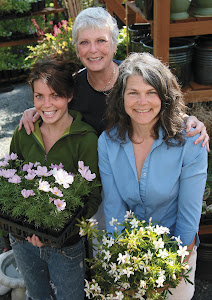Heather and dwarf Conifers are wonderful together, and make the perfect low maintenance Deer resistant duo.

Both are evergreen, and the conifers thrive in the same acidic, peaty soil favored by Heather. Our naturally acid soil makes them easy to grow here. Heathers need a well drained sunny spot that hasn't had too much fertilizer added.

Their shapes work well together, heathers spread out at a uniform level, where many dwarf conifers grow upwards and can be planted among them for vertical accents and colour contrasts. Additionally, you can use the trees as dividers to separate heathers of different types.In the late summer months when many perennials are waning, many of the Callunas are flowering heaviest. The winter blooming Ericas are natural selections for winter color. Erica carnea and E. x darlyensis start forming buds in early summer, that open as early as November in shades of pink, rose or white. These long lasting flowers are colorful all winter

Roughly figure 18" spacing when determining how many plants you will need (sq. ft. x .44 is the formula/ approx 4 Heathers per sq metre) for a large bed. Choose the taller growing varieties for the back or center of the bed and work your way to the edges, keeping in mind that the plants will grow into a solid mass of foliage leaving little bare ground exposed. I usually add one conifer for every 4 square metres. In very large beds you can use up to 20 of a single variety in each grouping. In smaller beds use groups of three or more of each type. Odd numbers work best.

You want contrasting foliage to define each grouping, so choose a gold or other colored foliage variety, then choose a silver, gray or dark green for the next grouping. Flower color is not as important as you may think but offset the mauves with white or light pinks if the plants are to bloom at the same time. Use the winter blooming Erica's' glossy green foliage as a buffer between a lot of Calluna.
 When planning a garden of heather, begin by making an outline of your area first. If you're planning a border, start from the back of the bed with the taller plants and work forward; if the bed is to be viewed from all sides, begin your design from the center out. Arrange them until the placement looks right to you.
When planning a garden of heather, begin by making an outline of your area first. If you're planning a border, start from the back of the bed with the taller plants and work forward; if the bed is to be viewed from all sides, begin your design from the center out. Arrange them until the placement looks right to you.
Other companion plants are: low growing Sedum's, Iberis, Hypericum, Lavender, Sempervivum, Allium, Arabis, Artemisia, Dianthus, Nepeta, Santolina, and Thyme to name a few perennials. Compact Cotoneaster, Vaccinum, Cytisus, grasses, and other leafy shrubs can also be interesting companion plants in a garden of heather.
We are lucky in Victoria to have a local Heather Society. You may view one of their demonstration garden's at Glendale Gardens. Check out their web-site if you would like to learn more.




No comments:
Post a Comment